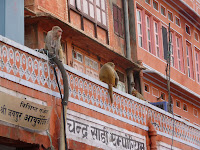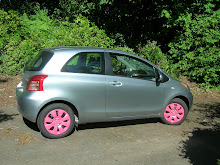"What India Offers to the Tourist
No region in the world is more colorful or picturesque than India [...] To the lover of nature, the botanist and the naturalist India offers every charm in forest, valley, cultivated plain, or desert waste. For the sportsman, India furnishes such as few countries do: tiger, panther, bear, elephant [...] To the mountaineer, the Himalayas offer the highest mountains in the world [...] The art collector and souvenir-hunter will reap a good harvest in this country."
The Handbook of India, 1958
The Handbook of India, 1958
So what is it that appeals to me about India? It must be more than just my love of bright colors. Why have I come back here twice now? Why did I want to learn Hindi? Why am I already daydreaming about my next Indian adventure? It doesn't make a lot of sense in many ways. It's hot here. It's dirty. The bathrooms are gross. I get harassed walking down the street. I can't dress the way I want to or go out alone or blend into my surroundings. I have to see devastating poverty on a daily basis. So where's the fun in that? Why would I love a place where I have to spend my birthday vomiting on the bathroom floor or where I wonder if every mosquito bite is malarial or where things go wrong so frequently that the first two phrases I learned in Hindi were kya hoa? (what happened?) and theek hai (it's fine)?
On a train recently the man sitting next to me asked me this same question--why India? I told him I didn't really know and he said, "In India we believe in reincarnation. You were Indian before. This is why."
The only explanation I can offer is this. I really love that in spite of everything that goes wrong here, nothing ever really goes wrong. In India even the horrible days are great. My vomit-colored birthday, for example, turned out to be one of the funniest and most memorable days of the summer. It didn't take me long in India to learn that trying to control any situation is futile. My plans inevitably get ruined, but something hilarious and exciting always ends up happening instead. When I learned to really let go here I learned that there is some kind of blissful peace to be found squeezing your way through the noisiest, sweatiest, most crowded bazaar. I learned that when food is so spicy that you sweat and cry that that is also when it tastes the best. I learned that when you are drenched from wading through monsoon-flooded streets that that is the most fun time to walk into a beauty salon. I learned that at that most inopportune moment for someone to knock on your door when you're not wearing pants and mid-way through washing your face, it might turn out to be the hotel staff there to give you a going-away present and Hindu blessing for safe travel home. I just never know what to expect here, but I always expect a fantastic experience.
I don't really know if that explains it.
I can say only one thing with certainty. In Jaisalmer, the crazy, shirtless, Aussie-slang-using owner of the restaurant where I was eating asked me how many times I had visited India. When I told him this was my second long trip he said, "Twice? Oh. So I think now you are addicted, no?"
"Yes," I said, "I'm definitely addicted."
On a train recently the man sitting next to me asked me this same question--why India? I told him I didn't really know and he said, "In India we believe in reincarnation. You were Indian before. This is why."
The only explanation I can offer is this. I really love that in spite of everything that goes wrong here, nothing ever really goes wrong. In India even the horrible days are great. My vomit-colored birthday, for example, turned out to be one of the funniest and most memorable days of the summer. It didn't take me long in India to learn that trying to control any situation is futile. My plans inevitably get ruined, but something hilarious and exciting always ends up happening instead. When I learned to really let go here I learned that there is some kind of blissful peace to be found squeezing your way through the noisiest, sweatiest, most crowded bazaar. I learned that when food is so spicy that you sweat and cry that that is also when it tastes the best. I learned that when you are drenched from wading through monsoon-flooded streets that that is the most fun time to walk into a beauty salon. I learned that at that most inopportune moment for someone to knock on your door when you're not wearing pants and mid-way through washing your face, it might turn out to be the hotel staff there to give you a going-away present and Hindu blessing for safe travel home. I just never know what to expect here, but I always expect a fantastic experience.
I don't really know if that explains it.
I can say only one thing with certainty. In Jaisalmer, the crazy, shirtless, Aussie-slang-using owner of the restaurant where I was eating asked me how many times I had visited India. When I told him this was my second long trip he said, "Twice? Oh. So I think now you are addicted, no?"
"Yes," I said, "I'm definitely addicted."





































